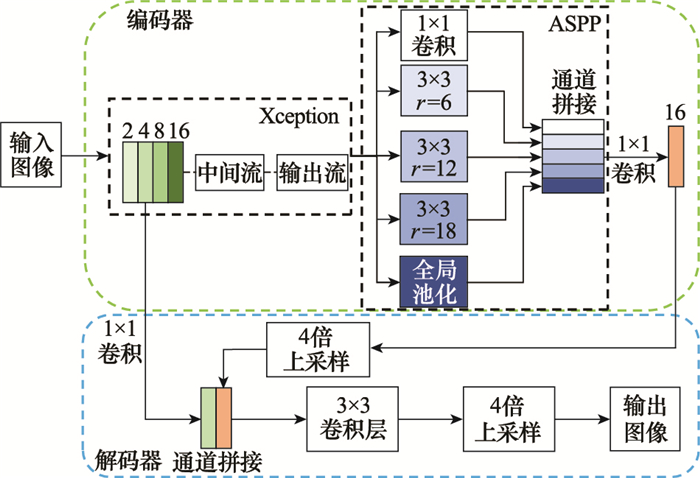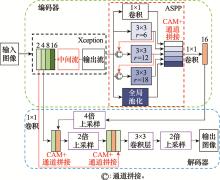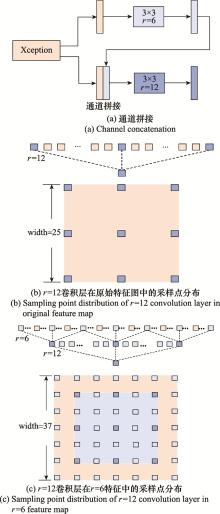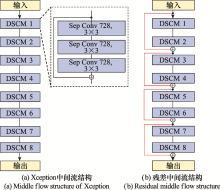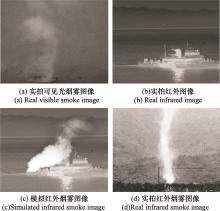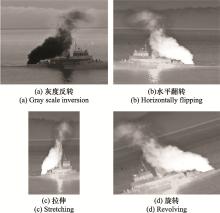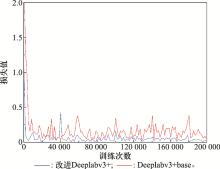Systems Engineering and Electronics ›› 2021, Vol. 43 ›› Issue (2): 328-335.doi: 10.12305/j.issn.1001-506X.2021.02.06
• Electronic Technology • Previous Articles Next Articles
Smoke region segmentation recognition algorithm based on improved Deeplabv3+
Zhiying LIU1( ), Chunsi XIE2(
), Chunsi XIE2( ), Jinjun LI2(
), Jinjun LI2( ), Yu SANG1(
), Yu SANG1( )
)
- 1. Midshipmen Group Five, Dalian Naval Academy, Dalian 116018 China
2. Department of Missile & Shipborne Gunnery, Dalian Naval Academy, Dalian 116018 China
-
Received:2020-06-01Online:2021-02-01Published:2021-03-16
CLC Number:
Cite this article
Zhiying LIU, Chunsi XIE, Jinjun LI, Yu SANG. Smoke region segmentation recognition algorithm based on improved Deeplabv3+[J]. Systems Engineering and Electronics, 2021, 43(2): 328-335.
share this article
| 1 |
HUANG L , SONG J M , ZHANG M Q , et al. Optical flow based guidance system design for semi-strapdown image homing guided missiles[J]. Chinese Journal of Aeronautics, 2016, 29 (5): 1345- 1354.
doi: 10.1016/j.cja.2016.08.011 |
| 2 | 齐航, 袁健全, 李磊, 等. 基于深度学习的红外烟幕区域分割技术[J]. 控制与信息技术, 2019, (4): 18- 22, 57. |
| QI H , YUAN J Q , LI L , et al. A method of smoke area segmentation for infrared images based on deep learning[J]. Control and Information Technology, 2019, (4): 18- 22, 57. | |
| 3 | YUAN J , YUAN W , JIA Y , et al. Renovated identifying method of the active infrared smoke based on the texture feature analysis[J]. Journal of Safety and Environment, 2016, 16 (2): 86- 89. |
| 4 | SONG W , WANG Y P , ZHANG W J , et al. Real-time smoke detection in substation based on color and motion features[J]. Transducer and Microsystem Technologies, 2015, 34 (12): 127- 130. |
| 5 | YUAN F N , SHI J T , XIA X . High-order local ternary patterns with locality preserving projection for smoke detection and image classification[J]. Information Sciences, 2016, 372 (1): 225- 240. |
| 6 | YE W , ZHAO J H , WANG S , et al. Dynamic texturebased smoke detection using surfacelet transformand HMT model[J]. Fire Safety Journal, 2015, 73 (4): 91- 101. |
| 7 |
NAYAK S R , MISHRA J . A modified triangle box-counting with precision in error fit[J]. Journal of Information and Optimization Sciences, 2018, 39 (1): 113- 128.
doi: 10.1080/02522667.2017.1372155 |
| 8 | PANIGRAHY C , AYAN S , NIHAR K M . Image texture surface analysis using an improved differential box counting based fractal dimension[J]. Powder Technology, 2020, 364 (15): 279- 299. |
| 9 | LIU A J, LU J, ZHANG G Q, et al. Concept drift detection via equal intensity k-means space partitioning[EB/OL].[2020-5-21].https://arxiv.org/abs/2004.11587. |
| 10 | ZHANG Q X, LIN G H, ZHANG Y M, et al. Wildland forest fire smoke detection based on faster R-CNN using synthetic smoke images[C]//Proc.of the Procedia Engineering, 2018: 441-446. |
| 11 |
梁杰, 李磊. 基于深度学习的红外图像遮挡干扰检测方法[J]. 兵工学报, 2019, 40 (7): 1401- 1410.
doi: 10.3969/j.issn.1000-1093.2019.07.009 |
|
LIANG J , LI L . Infrared image occlusion interference detection method based on deep learning[J]. Acta Armamentarii, 2019, 40 (7): 1401- 1410.
doi: 10.3969/j.issn.1000-1093.2019.07.009 |
|
| 12 | FRIZZI S, KAABI R. Convolutional neural network for video fire and smoke detection[C]//Proc.of the IEEE Industrial Electronics Society, 2016: 877-882. |
| 13 |
YIN Z J , WAN B Y , YUAN F N , et al. A deep normalization and convolutional neural network for image smoke detection[J]. IEEE Access, 2017, 5, 18429- 18438.
doi: 10.1109/ACCESS.2017.2747399 |
| 14 | XU G , ZHANG Y M , ZHANG Q X , et al. Video smoke detection based on deep saliency network[J]. Fire Safety Journal, 2019, 105 (9): 277- 285. |
| 15 | YUAN F N , ZHANG L , XIA X , et al. Deep smoke segmentation[J]. Neurocomputing, 2019, 357 (3): 248- 260. |
| 16 | 汪梓艺, 苏育挺. 一种改进Deeplabv3网络的烟雾分割算法[J]. 西安电子科技大学学报, 2019, 46 (6): 52- 59. |
| WANG Z Y , SU Y T . Algorithm for segmentation of smoke using the improved DeeplabV3 network[J]. Journal of Xidian University, 2019, 46 (6): 52- 59. | |
| 17 | LIANG M, HU X L. Recurrent convolutional neural network for object recognition[C]//Proc.of the IEEE Conference on Computer Vision and Pattern Recognition, 2015: 3367-3375. |
| 18 | LI X Q , CHEN Z X , WU Q M , et al. 3D parallel fully convolutional networks for real-time video wildfire smoke detection[J]. IEEE Trans.on Circuits and Systems for Video Technology, 2018, 30 (1): 89- 103. |
| 19 | LONG J , SHELHAMER E , DARRELL T . Fully convolutional networks for semantic segmentation[J]. IEEE Trans.on Pattern Analysis & Machine Intelligence, 2014, 39 (4): 640- 651. |
| 20 | RONNEBERGER O, FISCHER P, BROX T. U-Net: convolutional networks for biomedical image segmentation[EB/OL].[2020-05-22]. https://arxiv.org/abs/1505.04597. |
| 21 | CHEN L C, PAPANDREOU G, SCHROFF F, et al. Rethinking atrous convolution for semantic image segmentation[EB/OL]. [2020-5-22].https://arxiv.org/abs/1706.05587. |
| 22 | CHEN L C, ZHU Y, PAPANDREOU G, et al. Encoder-decoder with atrous separable convolution for semantic image segmentation[EB/OL].[2020-5-22].https://arxiv.org/abs/1802.02611. |
| 23 | 杨波,陶青川,董沛君.改进Deeplab v3+网络的手术器械分割方法[EB/OL].[2020-05-22]. http://kns.cnki.net/kcms/detail/11.2127.TP.20200221.0832.004.html. |
| YANG B, TAO Q C, DONG P J, et al. Surgical instrument segmentation method based on improved Deeplabv3+network[EB/OL]. Computer Engineering and Applications: 1-7[2020-05-22]. http://kns.cnki.net/kcms/detail/11.2127.TP.20200221.0832.004.html. | |
| 24 | HE K M, ZHANG X Y, REN S Q, et al. Deep residual learning for image recognition[C]//Proc.of the IEEE Computer Society Conference on Computer Vision and Pattern Recognition, 2016: 770-778. |
| 25 | HU J, SHEN L, SUN G. Squeeze-and-excitation Networks[C]// Proc.of the IEEE Computer Society Conference on Computer Vision and Pattern Recognition, 2018: 7132-7141. |
| [1] | Xiao HAN, Shiwen CHEN, Meng CHEN, Jincheng YANG. Open-set recognition of LPI radar signal based on reciprocal point learning [J]. Systems Engineering and Electronics, 2022, 44(9): 2752-2759. |
| [2] | Limin ZHANG, Kaiwen TAN, Wenjun YAN, Yuyuan ZHANG. Radar emitter recognition based on multi-level jumper residual network [J]. Systems Engineering and Electronics, 2022, 44(7): 2148-2156. |
| [3] | Guodong JIN, Yuanliang XUE, Lining TAN, Jiankun XU. Advances in object tracking algorithm based on siamese network [J]. Systems Engineering and Electronics, 2022, 44(6): 1805-1822. |
| [4] | Xiaofeng ZHAO, Yebin XU, Fei WU, Jiahui NIU, Wei CAI, Zhili ZHANG. Ground infrared target detection method based on global sensing mechanism [J]. Systems Engineering and Electronics, 2022, 44(5): 1461-1467. |
| [5] | Hong ZOU, Chenyang BAI, Peng HE, Yaping CUI, Ruyan WANG, Dapeng WU. Edge service placement strategy based on distributed deep learning [J]. Systems Engineering and Electronics, 2022, 44(5): 1728-1737. |
| [6] | Dong CHEN, Yanwei JU. Ship object detection SAR images based on semantic segmentation [J]. Systems Engineering and Electronics, 2022, 44(4): 1195-1201. |
| [7] | Jingming SUN, Shengkang YU, Jun SUN. Pose sensitivity analysis of HRRP recognition based on deep learning [J]. Systems Engineering and Electronics, 2022, 44(3): 802-807. |
| [8] | Yunxiang YAO, Ying CHEN. Target tracking network based on dual-modal interactive fusion under attention mechanism [J]. Systems Engineering and Electronics, 2022, 44(2): 410-419. |
| [9] | Yongxing GAO, Xudong WANG, Ling WANG, Daiyin ZHU, Jun GUO, Fanwang MENG. Weather signal detection for dual polarization weather radar based on RCNN [J]. Systems Engineering and Electronics, 2022, 44(11): 3380-3387. |
| [10] | Yiheng ZHOU, Jun YANG, Saiqiang XIA, Mingjiu LYU. Estimation method of micro-motion parameters for rotor targets under flashing [J]. Systems Engineering and Electronics, 2022, 44(1): 54-63. |
| [11] | Rong FU, Tianyao HUANG, Yimin LIU. DNN based 1-bit block sparse recovery in frequency agile coherent radar [J]. Systems Engineering and Electronics, 2022, 44(1): 70-75. |
| [12] | Yuyuan ZHANG, Limin ZHANG, Wenjun YAN. SFBC-OFDM recognition method based on cross-correlation feature map and dilated dense convolutional neural networks [J]. Systems Engineering and Electronics, 2021, 43(9): 2657-2664. |
| [13] | Caiyun WANG, Yangyu LI, Xiaofei LI, Jianing WANG, Wenyi WEI. Aerial image super-resolution restruction based on sparsity and deep learning [J]. Systems Engineering and Electronics, 2021, 43(8): 2045-2050. |
| [14] | Yueping HUANG, Xiaofeng LI, Xiaogang YANG, Naixin QI, Ruitao LU, Shengxiu ZHANG. Advances in visual object tracking algorithm based on correlation filter [J]. Systems Engineering and Electronics, 2021, 43(8): 2051-2065. |
| [15] | Bin WANG, Guoyu WANG. Instantaneous coastline automatic extraction algorithm for SAR images based on improved deep learning network [J]. Systems Engineering and Electronics, 2021, 43(8): 2108-2115. |
| Viewed | ||||||
|
Full text |
|
|||||
|
Abstract |
|
|||||

